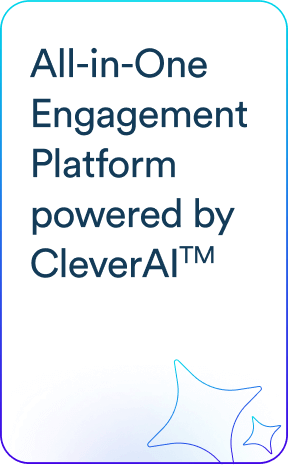Segmenting customers into distinct groups depending on their shared characteristics is central to developing personalized marketing campaigns. With demographic segmentation, you can do just that, leading to better engagement and increased ROI.
This guide will explore the concept of demographic segmentation, its benefits, key variables, and how to leverage it for marketing success.
What is Demographic Segmentation?
Demographic segmentation divides your existing and potential customers into distinct categories based on their common traits, such as age, gender, education, income, and occupation.
These shared traits influence how users react and respond to your marketing campaigns and thus help you target the right people with the right message. When done right, demographic market segmentation enables you to ensure optimum utilization of their resources.
It is important to note here that demographic segmentation is an ongoing process. You may need to adjust your segmentation criteria periodically based on evolving market conditions and business objectives. For example, a travel and tours company would want to know the marital status, number of children, household income, and other details before launching a new holiday package.
Demographic Segmentation Variables With Examples
A business can use a demographic variable or a combination of variables to create customer groups. Let’s take a look at demographic segmentation examples, taking into account some of the most widely used demographic segmentation variables:

1. Age
People within the same age group often share similar tastes, preferences, and lifestyles. Understanding these patterns allows businesses to create targeted customer segments based on buying personas, enabling more personalized marketing campaigns.
Below are the standard generational classifications based on birth years:
- Baby Boomers (1946–1964)
- Generation X (Gen X) (1965–1979)
- Millennials (1980–1994)
- Generation Z (Gen Z) (1995–2012)
- Generation Alpha (Gen Alpha) (2013–2025)
For example, companies in the food industry might target Gen Alpha with fast food, snacks, chocolates, and candies, while offering healthier options to Gen Z and older generations. With increasing global health awareness, food brands now emphasize nutritional benefits in their marketing messages to stay relevant to health-conscious consumers.
Similarly, consider a skincare company targeting customers aged 16 to 60. Marketing strategies would vary by age group:
- Ages 16–25: Social media and influencer marketing on platforms like TikTok and Instagram, focusing on trends such as “glass skin” and blemish-free complexions.
- Ages 25–40: A mix of social media and television advertising, highlighting benefits like sun protection, wrinkle prevention, and anti-aging solutions.
Businesses can maximize customer engagement and improve campaign effectiveness by tailoring marketing efforts to generational behaviors and preferences.
2. Gender
Segmentation by gender allows marketers to address the distinct needs and preferences of men and women.
For example, beauty and personal care products are often marketed differently to males and females to align with their specific preferences. A skincare brand may market oil-control face washes and rugged fragrances to men while promoting anti-aging serums and floral-scented products to women.
Athletic brands like Nike and Adidas design separate product lines for men and women, with gender-specific fits, colors, and styles.
3. Income
Income levels influence purchasing power and can guide the promotion of products ranging from luxury items to budget-friendly options.
For example, a car company might market its luxury vehicles to individuals with higher incomes while promoting more affordable models to those with lower incomes.
4. Education Level
Educational attainment can affect consumer interests and product choices.
For instance, a company offering advanced professional courses may target individuals with higher education levels who are seeking specialized knowledge.
5. Occupation
Profession plays a role in shaping consumer needs and purchasing behavior. For example, a software company may create versions of their software tailored to different industries, such as retail, finance, and healthcare sectors.
Examples of demographic segmentation based on occupation include:
- Software Companies: Adobe promotes Photoshop to graphic designers, while QuickBooks markets its accounting software to small business owners.
- Workwear and Fashion: Brands like Carhartt and Dickies design durable clothing for construction workers, while Brooks Brothers and Hugo Boss target corporate professionals with formal wear.
- Banking: Financial institutions offer different products based on occupations, such as high-yield savings accounts for professionals with stable incomes and student loan refinancing for recent graduates.
6. Marital Status and Family Size
These factors can influence purchasing decisions, particularly for products like housing, automobiles, and family-oriented services. For instance, a travel agency might offer vacation packages specifically designed for single travelers, couples, or families with children.
- To a single person, you could offer a “trip with friends” to domestic locations for people within a certain income range or Coachella or Tomorrowland packages for people belonging to higher income ranges.
- To a couple, you could offer a “couple getaway” to domestic destinations for people in a lower income range and international destinations like Bali, Maldives, or Paris, for people belonging to higher income ranges.
- To a couple with kids, you could offer a “summer vacation trip” to domestic destinations for people within a certain income range and international destinations like Europe or Singapore, which could include trips to museums and amusement parks.
7. Ethnicity, Religion, and Culture
Cultural background and religious beliefs can impact consumer preferences and behaviors. For example, food companies may offer products that cater to specific dietary restrictions associated with certain religions or cultural practices.
For example, the global fast food chain company McDonald’s offers certain food items in certain countries to cater to the tastes and preferences of people in those countries. This includes offering soup in Portugal, McPinto Deluxe (a traditional dish) in Costa Rica, McPatongko (street food) in Thailand, Nasi Lemak in Malaysia, vegetarian and vegan burgers, and so on.
What are the Benefits of Demographic Segmentation?
Demographic segmentation enables you to understand the composition of your customer pool and create groups that you can then target with more relevant messaging. Adopting this as part of your marketing strategy can engender a number of benefits.
1. Better Personalization
Creating customer segments based on demographic factors enables you to use more relevant and personalized messaging that resonates better with the targeted group.
For example, a streaming app could do an email campaign for a new anime movie for couples with kids, or a food delivery app could send a push notification to people with jobs to order something delicious to get rid of Monday blues.
2. Improved Product-Market Fit
Understanding who your target customers are and their preferences can significantly help align product development to meet the customers’ evolving needs.
For example, with the growing environmental, social and governance (ESG) awareness of people belonging to the Gen Z and Millennial age groups, a lot of cosmetics companies today develop and market their products using messaging such as cruelty-free and environment-friendly packaging.
3. Enhanced Marketing and Advertising Effectiveness
Marketing and advertising campaigns and initiatives that are developed to cater to a specific customer demographic segment will always be more impactful and effective than a more generic, one-size-fits-all approach.
With demographic market segmentation, you can target customers that are more relevant to you and more likely to make a purchase, thereby ensuring optimum utilization of the marketing budget with higher return on ad spend (ROAS) and lower customer acquisition cost (CAC).
4. Better Customer Retention
Demographic market segmentation allows you to bring the element of personalization into your marketing efforts. For the end user, this makes them feel valued and, in turn, helps you improve customer loyalty, satisfaction, and retention.
5. Optimal Pricing and Distribution
Grouping customers based on their income provides you with insights into their buying behavior. This information can help you determine the right price for your products and the right channels that ensure maximum outreach.
How to Use Demographic Segmentation for Marketing Strategies?
Here’s a step-by-step guide to effectively using demographic segmentation in your marketing efforts:

Step 1: Collect and Analyze Customer Data
Before segmenting your audience, clarify your marketing objectives. Are you trying to increase brand awareness, drive sales, or improve customer retention? Clear goals will help determine which demographic variables to prioritize. Gather data on your existing and potential customers through various methods:
- Surveys & Questionnaires: Directly ask customers about their age, income, lifestyle, and preferences.
- Website & Social Media Analytics: Use tools like Google Analytics, Facebook Insights, and Instagram Analytics to track demographic trends.
- CRM & Purchase History: Analyze customer data in your CRM system to identify common demographic patterns.
Step 2: Identify Key Demographic Variables and Create Customer Segments
Choose the most relevant demographic factors based on your product or service. Divide your audience into smaller, well-defined groups based on the chosen variables. For example:
- A fitness brand may target young professionals (ages 25-35) interested in high-intensity workouts and busy parents (ages 35-50) looking for quick, at-home exercises.
- A car company might market luxury SUVs to high-income professionals and affordable compact cars to college students and young adults.
Step 3: Develop Personalized Marketing Messages
Customize your messaging, visuals, and tone for each segment. Examples include:
- Social Media Ads for Gen Z: Use platforms like TikTok and Instagram with influencer collaborations and trending hashtags.
- Email Marketing for Baby Boomers: Send personalized newsletters highlighting product reliability and long-term value.
- Video Campaigns for Millennials: Use YouTube ads and engaging storytelling content to showcase experiences.
Step 4: Test and Optimize Your Strategy
Monitor your campaigns and adjust based on performance metrics. Track engagement rates, click-through rates, and conversions for each segment. A/B test different messages, offers, and visuals to see what resonates best. Use customer feedback to refine your market segmentation strategy and improve targeting.
Step 5: Continuously Update Demographic Data
Consumer behavior evolves, so regularly update your demographic data and segmentation approach. Keep track of market trends and economic shifts that impact consumer purchasing behavior and new technologies that influence marketing effectiveness.
Using the Right Demographic Segmentation Tool: How CleverTap Can Help
To create the right demographic segments and drive tailored marketing campaigns, you need a robust technology-based analytics platform.
CleverTap enables you to understand your target audience, create demographic segments, and engage with them efficiently and effectively with the ability to scale as needed. It leverages real-time behavioral data to identify specific customer groups, thereby enabling you to deploy personalized marketing campaigns that are relevant to each segment.
CleverTap helps you enhance customer segmentation with a range of advanced tools and technologies, including:
- Behavioral analytics: Analytics capabilities help create detailed customer profiles by tracking customer interactions across multiple touchpoints.
- Real-time data processing: This helps ensure timely and relevant customer interactions by capturing and processing data in real time.
- Omnichannel engagement: Omnichannel engagement features provide a 360-degree view of customer behavior by seamlessly integrating data from multiple channels.
- Clever.AI: CleverTap’s built-in AI capabilities, Clever.AI, enable driving more effective segmentation and targeted campaigns by using predictive analytics.
- TesseractDB: CleverTap’s TesseractDB helps drive comprehensive user data retention and analysis with unmatched data granularity and scalability.
- Lifecycle optimizer: Finally, lifecycle optimizer helps continually optimize customer journeys by automating and improving customer interactions across their lifecycle.
Conclusion
Knowing your customers is the first step in developing a targeted, personalized, and effective marketing strategy. Demographic segmentation enables you to “speak” directly to the customers, make them feel valued, and foster their long-lasting loyalty.
Kiran Pius 
Leads Product Launches, Adoption, & Evangelism.Expert in cross-channel marketing strategies & platforms.
Free Customer Engagement Guides
Join our newsletter for actionable tips and proven strategies to grow your business and engage your customers.














































![What is Demographic Segmentation & How to Use It [+ Examples]](https://clevertap.com/wp-content/uploads/2024/10/Demographic-Segmentation.png?w=1024&w=721)